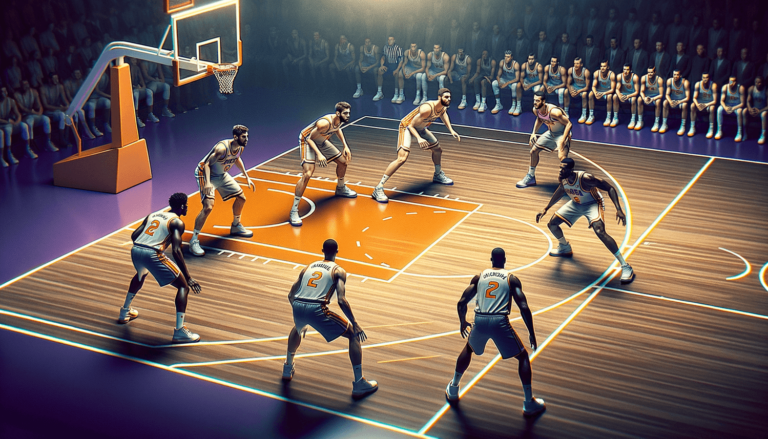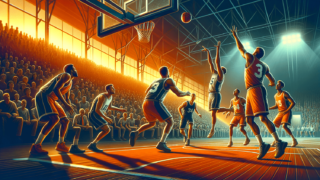
Welcome to our deep dive into the chess match that is basketball strategy! Today, we’re focusing on a defensive scheme that’s a favorite among coaches who love to keep opposing offenses on their toes: the 1-2-2 Half-Court Press. If you’ve been longing to understand the ins and outs of this intriguing maneuver, you’ve come to the right place. Join us as we break down each player’s role, the benefits and potential pitfalls of deploying this press, and the keys to making it work in the heat of the game. Whether you’re a curious fan or an aspiring basketball tactician, we’ve got all the answers you seek, served up with a fun and professional vibe.
What’s a 1-2-2 Half-Court Press in Basketball?
A 1-2-2 Half-Court Press is a defensive strategy in basketball, designed to disrupt the opposing team’s offense by applying pressure at the half-court line. The formation consists of one player positioned near the half-court line, two players just behind them, and two more players near the baseline. This aggressive setup forces opponents to make quick decisions and execute precise passes, increasing the likelihood of turnovers and rushed shots.
Understanding the 1-2-2 Half-Court Press Formation
Before diving deep into the working mechanism of the 1-2-2 Half-Court Press, it’s essential to understand the positions of the players on the court. The formation gets its name from the arrangement of the players: 1 at the top (point guard), 2 in the middle (shooting guards or wings), and 2 at the bottom (forwards or post players). Let’s explore the roles and responsibilities of each player in the 1-2-2 lineup.
1 – Point Guard (Top Player)
The point guard, often the team’s fastest and most agile player, is the first line of defense in the 1-2-2 Half-Court Press. They take up a position near the half-court line and are responsible for applying immediate pressure on the ball handler. By staying low and active, this player can disrupt the opponent’s offensive flow and limit their passing options. The point guard’s goal is to steer the ball handler toward a sideline, essentially using the out-of-bounds line as an extra defender.
2 – Wings (Middle Players)
While the point guard puts pressure on the ball handler, the wings have two crucial tasks: prevent penetration and intercept passes. Positioned just behind the top player, the wings use their height and wingspan to deny passing lanes, aiming to disrupt or steal passes toward the wings or corners. They communicate with the top player to anticipate the opponent’s next move, all while remaining agile enough to recover and defend their designated area of the court.
3 – Forwards (Bottom Players)
The bottom two players (forwards or post players), slightly above the baseline, are vital to the defensive scheme’s success. Equipped with size, speed, and basketball IQ, their primary role is to leave no open space for the opponent to exploit. They must be quick to rotate when necessary, clog the passing lanes, and provide help defense for the middle players. Additionally, they must be ready to rebound, as the press can often lead to low-percentage shots by the opposition.
Breaking Down the 1-2-2 Press in Action
Now that we’ve established the player positions let’s analyze how the 1-2-2 Half-Court Press unfolds during a game.
Initiating the Press
As the opposing team’s point guard crosses the half-court line, the defender at the top of the 1-2-2 quickly closes the gap to prevent easy penetration. The defensive wings simultaneously shadow the opposing wings, ready to deny or intercept passing opportunities. The bottom two players remain focused on defending the low post and blocking passing lanes to the paint while securing any rebounds.
Trapping and Rotating
With the ball handler forced toward the sideline, the 1-2-2 Press seeks to create a trapping situation. The wing defender closest to the ball handler will move to apply extra pressure, effectively trapping the opponent between the top player, wing defender, and the sideline. This aggressive move increases the chances of a bad pass or turnover.
However, trapping leaves a temporary opening on the court, and this is where excellent communication and rotations are crucial. The bottom player opposite the trap moves to cover the targeted wing area, and the remaining bottom player stays in the paint, preventing any easy baskets at the rim.
Reverting to Half-Court Defense
If executed effectively, the 1-2-2 Half-Court Press forces the opponent to make rushed decisions, increasing the likelihood of turnovers or hurried shots. However, if the offensive team manages to bypass the press, it’s crucial for the defense to revert to a half-court set efficiently. This transition often involves the top player funneling back to protect the basket while the wings and forwards recover to their designated defensive assignments.
Devising Strategies for the 1-2-2 Half-Court Press Success
While each team has its unique way of approaching and executing the 1-2-2 Half-Court Press, there are certain strategies and tactics that can enhance the press’s efficiency and effectiveness.
Disguising the Press
A successful press often involves clever deception. Teams can disguise the 112 Half-Court Press by adopting different defensive formations, only to switch into the press at the last moment. This tactic keeps the offense on edge and forces them to make on-the-spot adjustments, significantly increasing the potential for mistakes.
Constant Communication
Strong communication is indispensable for any defensive scheme, but it is especially crucial for the 1-2-2 Half-Court Press. Players must actively relay information about their opponents’ moves and positioning to coordinate defensive rotations effectively. Clear and precise communication serves as the backbone of a successful 1-2-2 Half-Court Press.
Adapting to the Opponent’s Strategy
In basketball, as in any competitive sport, tactical adjustments can make or break a team’s success. Defenses must remain flexible and adaptable, recognizing opponents’ patterns and reacting accordingly. Sometimes, adjustments involve switching from a 1-2-2 formation to a different press, such as a 1-3-1 or man-to-man, to keep the offense guessing.
Strengths and Weaknesses of the 1-2-2 Half-Court Press
Like any basketball strategy, the 1-2-2 Half-Court Press has its merits and demerits. Understanding these is essential when deciding whether to implement this defensive approach in a game.
Strengths:
- Disrupts opponents’ offensive flow, leading to more forced passes and turnovers.
- Capitalizes on defensive pressure and effectively employs the sideline as an extra defender.
- Rattles the opposing team mentally, causing them to struggle with offensive execution.
- Maximizes the potential for fast-break opportunities due to forced turnovers.
Weaknesses:
- Relies heavily on defensive speed, communication, and rotations, demanding high levels of coordination and conditioning.
- Prone to leaving open lanes if a trap or rotation is unsuccessful.
- Can lead to foul trouble if players are overly aggressive with trapping or reaching for steals.
When to Implement the 1-2-2 Half-Court Press
The 1-2-2 Half-Court Press is not an all-or-nothing strategy; however, knowing when to deploy it can give your team a significant advantage on the court. Situational awareness and analysis of the opposition’s strengths and weaknesses are key factors in making such decisions.
Speed Advantage
If your team boasts faster players, the 1-2-2 Half-Court Press might be the perfect tool to exploit this attribute. Your players’ quickness will help disrupt the opposing offense and force turnovers, significantly increasing your opportunities for transition baskets.
Momentum Shifts
When looking to turn the tide of a game, the 1-2-2 Half-Court Press can provide a psychological edge. Trapping opposing guards can stall their offensive rhythm, forcing hurried and off-balance shots. This disruptive defense can redefine the tempo of the match in your favor.
Capitalizing on Inexperienced Guards
If the opposition has inexperienced guards, testing their skills with the 1-2-2 Half-Court Press can bear fruit. Young or untested playmakers facing a well-coordinated press can make mistakes, struggle with decision-making, and become rattled.
The Keys to Mastering the 1-2-2 Half-Court Press
The 1-2-2 Half-Court Press is undeniably an effective weapon in the basketball arsenal, but like any complex strategy, it requires dedicated practice and teamwork. Here are some essential aspects to consider when honing your team’s skills in the 1-2-2 Half-Court Press.
Develop Conditioning and Stamina
Press defenses demand high levels of energy and endurance. Coaches should prioritize conditioning drills in practice, ensuring their athletes can maintain a high level of intensity throughout the game without compromising their performance.
Emphasize Communication
Ensure each player understands their role, from initiating the press to proper rotations. Foster a team culture that encourages communication, as it’s integral to the 1-2-2 Press’s success. Reiterate the need for loud, clear instructions on the court, as seamless rotations rely on precise, real-time information.
Focused Drills
Practice drills should emphasize trap situations, defensive rotations, and ball denial. Repetition is vital, allowing players to build the necessary muscle memory and instincts required when executing the press in real game situations.
Now that you understand the intricacies of the 1-2-2 Half-Court Press, you can confidently implement or counteract this strategy, whether you’re an aspiring coach or an
Recognizing and Overcoming Press Defenses
While the focus of this article has been on implementing the 1-2-2 Half-Court Press, understanding how to identify and break down press defenses is equally important for both coaches and players. By knowing the keys to overcoming press defenses, you’ll find yourself better prepared to succeed against the 1-2-2 Half-Court Press and its many variations.
Recognizing the Press
Learning how to read an opponent’s defensive scheme is a valuable skill for coaches and players alike. Watch for opposing players’ positioning and changes in their defensive intensity. The presence of an opponent pressuring the ball handler immediately past the half-court line, wings sagging off of their opponents, and forwards denying passes to low post players are telltale signs of a team utilizing the 1-2-2 Half-Court Press.
Spacing and Passing
Spacing the floor effectively is crucial for overcoming press defenses. By spreading out, the offense can stretch the defense, leading to open lanes and passing opportunities. Quick, sharp passes are essential for breaking down press defenses, as they force defenders to chase the ball and create further gaps across the court.
Patient Decision-Making
Press defenses aim to rush the offense into making bad decisions. Maintaining patience and composure can be key to unlocking a press defense. Keep the ball moving, and don’t let the defense dictate the pace of the game. Trust your teammates and have confidence in your ability to make smart decisions under pressure.
Further Variations of Press Defenses
Beyond the 1-2-2 Half-Court Press, several other press defensive strategies can give your team the upper hand on the court. Exploring these variations can enrich your coaching arsenal and provide insight into recognizing and dismantling the defenses mounted by opponents.
1-3-1 Half-Court Press
The 1-3-1 Half-Court Press is a popular defensive mechanism that prioritizes perimeter pressure and disrupts passing lanes. It features one player at the top, three across the middle, and one anchoring the formation near the basket. This defense can be particularly effective against teams that rely on quick ball movement and perimeter shooting.
2-2-1 Full-Court Press
The 2-2-1 Full-Court Press looks to trap the opponent in their backcourt, utilizing two defenders up front, two more near half-court, and one positioned closer to the basket. This aggressive pressing technique looks to force turnovers early in the opponent’s possession and can be devastating when executed effectively.
Man-to-Man Press and Trapping
A team that applies pressure through a man-to-man defensive scheme can cause chaos on the court. By closely guarding opponents and working in tandem to create trapping situations, defenses can stifle even the most well-coordinated offenses. The key for a successful man-to-man press lies in individual defensive prowess and effective communication between teammates.
With the knowledge gained about the 1-2-2 Half-Court Press and its built-in strategies, you have a solid understanding of how press defenses operate, and how to counteract them. Incorporating these techniques into your coaching or playing arsenal will help you better navigate defensive challenges on a basketball court.
Frequently Asked Questions
We’ve prepared a list of frequently asked questions related to the 1-2-2 Half-Court Press and other press defenses. This section is designed to provide further insight and clarification on the topic, so feel free to explore the questions and answers below to fuel your passion for basketball knowledge.
1. Can the 1-2-2 Half-Court Press be used for youth basketball teams?
Yes, the 1-2-2 Half-Court Press can be an effective defensive strategy for youth basketball teams. It helps young players develop fundamental defensive skills such as communication, quick rotations, and decision-making under pressure. However, it is essential to breakdown and teach the strategy thoroughly to ensure players understand their responsibilities on the court.
2. How does the 1-2-2 Half-Court Press differ from a full-court press?
The key difference between the 1-2-2 Half-Court Press and a full-court press lies in the area of the court where defensive pressure is applied. While the 1-2-2 Half-Court Press focuses on applying pressure at half-court, a full-court press seeks to trap the opponent in their backcourt, increasing the likelihood of turnovers further from the basket.
3. How can a point guard successfully handle the pressure of a 1-2-2 Half-Court Press?
To handle the pressure of a 1-2-2 Half-Court Press, a point guard can employ the following tactics: maintain composure, use efficient dribbling techniques to create space, communicate with teammates to make use of screens and available passing options, and make quick decisions to pass the ball to open players before the trap is completed.
4. Are there any specific strategies to beat the 1-2-2 Half-Court Press?
To beat the 1-2-2 Half-Court Press, consider the following strategies: space the floor effectively, use sharp and quick passes to keep the defense off balance, exploit gaps in the defense after traps are initiated, and employ effective decision-making under pressure. Additionally, utilizing skip passes and looking for diagonal passing options can help break down this defensive scheme.
5. How often should a team use the 1-2-2 Half-Court Press during a game?
The frequency of using the 1-2-2 Half-Court Press in a game depends on its effectiveness, the team’s stamina, and the coach’s strategy. Some coaches may choose to use it sporadically to disrupt their opponent’s offensive flow or to shift momentum. Others may employ it as their primary defensive strategy for significant periods of the game. Ultimately, the decision is situational and should be based on the unique context of each game.
6. How do teams practice executing the 1-2-2 Half-Court Press?
Teams practice the 1-2-2 Half-Court Press using focused drills that emphasize trap situations, defensive rotations, and ball denial. Coaches must ensure clear communication is a priority during practices. Repetition is essential for building muscle memory and instincts, allowing players to execute the press seamlessly in real game situations.
7. What positions are best suited for each role in the 1-2-2 Half-Court Press?
In the 1-2-2 Half-Court Press, the point guard typically takes the role of the top player applying pressure to the ball handler. Shooting guards or small forwards act as the wings (middle players) who deny passes and assist in trapping. Power forwards and centers generally assume the role of the bottom (post) players, securing rebounds and clogging passing lanes.
8. How do 1-2-2 Half-Court Press defenders avoid committing fouls during trapping situations?
To avoid fouls during trapping situations in a 1-2-2 Half-Court Press, defenders should maintain a low and balanced stance while keeping their hands up and moving their feet to stay in front of the ball handler. They should avoid overly aggressive actions such as reaching for steals, which can result in personal fouls.
9. Can the 1-2-2 Half-Court Press be used alongside other press defenses?
Yes, the 1-2-2 Half-Court Press can be effectively combined with other press defenses like the 1-3-1 Half-Court Press or the 2-2-1 Full-Court Press. Changing defensive formations throughout the game can confuse and disrupt the opponent’s offense, making it difficult for them
Featured Posts
- No pillar pages found.





